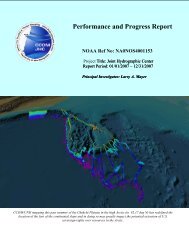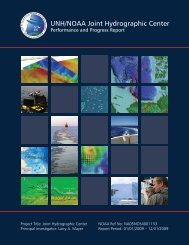Performance and Progress Report - John Doe FIX: put in the authors ...
Performance and Progress Report - John Doe FIX: put in the authors ...
Performance and Progress Report - John Doe FIX: put in the authors ...
Create successful ePaper yourself
Turn your PDF publications into a flip-book with our unique Google optimized e-Paper software.
IMPROVED SIDESCAN SONAR AND BACKSCATTER PROCESSING:<br />
Geocoder:<br />
While our <strong>in</strong>itial data process<strong>in</strong>g efforts focused on improv<strong>in</strong>g bathymetric process<strong>in</strong>g, it<br />
has become <strong>in</strong>creas<strong>in</strong>gly clear that <strong>the</strong>re is also a great need for improved process<strong>in</strong>g of<br />
backscatter data (both from multibeam sonars <strong>and</strong> sidescan sonars). With this <strong>in</strong> m<strong>in</strong>d,<br />
we began, <strong>in</strong> 2005, a new effort aimed at improv<strong>in</strong>g <strong>the</strong> suite of backscatter process<strong>in</strong>g<br />
tools available to us <strong>and</strong> NOAA. Our aim was two-fold: 1- to develop easy to use tools<br />
that will generate “pretty” images of sidescan sonar or multibeam backscatter that will be<br />
suitable for small object detection as well as geologic <strong>and</strong> habitat <strong>in</strong>terpretation, <strong>and</strong>; 2-<br />
to develop tools that allow for <strong>the</strong> quantitative analysis of backscatter data <strong>in</strong> support of<br />
seafloor characterization <strong>and</strong> small object identification.<br />
In an effort to meet <strong>the</strong>se two objectives, we started a lab-wide effort to develop a new<br />
suite of backscatter process<strong>in</strong>g tools. This effort is be<strong>in</strong>g led by Luciano Fonseca with<br />
<strong>in</strong><strong>put</strong> from many o<strong>the</strong>rs. The goal is to create an <strong>in</strong>tegrated suite of tools that will allow<br />
us to import backscatter or sidescan data from a number of sensors (<strong>in</strong> various formats,<br />
<strong>in</strong>clud<strong>in</strong>g Reson snippet data), convert <strong>the</strong>se data to an <strong>in</strong>ternal GFS format, correct <strong>the</strong>se<br />
data (where possible) for source levels, beam patterns, ga<strong>in</strong>s, area ensonified, attenuation,<br />
<strong>and</strong> local slope, <strong>and</strong> <strong>the</strong>n ei<strong>the</strong>r analyze <strong>and</strong>/or display <strong>the</strong>se data <strong>in</strong> a georeferenced<br />
mosaic. A number of modules have now been developed <strong>in</strong>clud<strong>in</strong>g GEOCODER, a C++<br />
mosaick<strong>in</strong>g tool that now reads directly from GSF or XTF files (<strong>in</strong>clud<strong>in</strong>g Reson snippet<br />
data), corrects data for ga<strong>in</strong>s <strong>and</strong> removes speckle. Special attention has been given to<br />
correct<strong>in</strong>g for beam patterns. Normally, <strong>the</strong> empirical beam pattern correction is<br />
calculated as <strong>the</strong> residual necessary to flatten <strong>the</strong> angular response registered by <strong>the</strong> sonar<br />
system, i.e. to normalize <strong>the</strong> backscatter at 45 degrees, (sometimes add<strong>in</strong>g a Lambertian<br />
correction). The new approach now used by Geocoder calculates <strong>the</strong> beam pattern as <strong>the</strong><br />
residual to <strong>the</strong> modeled angular response of <strong>the</strong> ensonified seafloor which <strong>the</strong>n reveals<br />
<strong>the</strong> actual non-l<strong>in</strong>earity of <strong>the</strong> transducer angular response.<br />
Data is <strong>the</strong>n geocoded <strong>in</strong> a projected coord<strong>in</strong>ate system us<strong>in</strong>g an <strong>in</strong>terpolation scheme<br />
that emulates <strong>the</strong> acquisition geometry.<br />
Along with <strong>the</strong> full time series backscatter data from both Reson <strong>and</strong> Simrad systems,<br />
GEOCODER also fully supports average beam backscatter data from <strong>the</strong>se systems. A<br />
fea<strong>the</strong>r<strong>in</strong>g algorithm to smooth <strong>the</strong> transition between overlapp<strong>in</strong>g l<strong>in</strong>es has been added<br />
along with an anti-alias<strong>in</strong>g algorithm that makes it possible to produce a lower resolution<br />
mosaic that is not degraded by alias<strong>in</strong>g, a process for slant-range correction based on<br />
actual bathymetry, <strong>and</strong> a trend-adaptive angle-vary<strong>in</strong>g ga<strong>in</strong> that helps remove artifacts<br />
that appear when different bottom types are found along a s<strong>in</strong>gle swath. L<strong>in</strong>es can be<br />
removed or remosaicked, <strong>and</strong> <strong>the</strong> overlap area between parallel l<strong>in</strong>es can be controlled by<br />
filter parameters. GEOCODER also supports a statistical package that identifies patterns<br />
<strong>in</strong> <strong>the</strong> backscatter response that can be used <strong>in</strong> support of seafloor characterization (see<br />
below). Statistics calculated for backscatter b<strong>in</strong>s <strong>in</strong>clude: mean, mode, range, m<strong>in</strong>imum,<br />
maximum, st<strong>and</strong>ard deviation, variance, percentiles, quartile range, skewness, kurtosis,<br />
moments of any order, <strong>and</strong> also parameters extracted from a gray level co-occurrence<br />
matrix (contrast, homogeneity, dissimilarity, entropy <strong>and</strong> energy). Tak<strong>in</strong>g advantage of<br />
JHC <strong>Performance</strong> <strong>Report</strong> 31 30 January 2007




